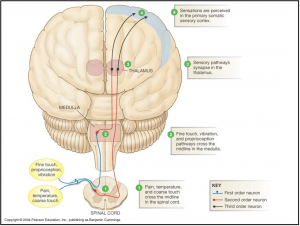2 The Labeled Line Principle
Learning objective 2. To understand the labeled-line principle of signal detection
Sensory receptors typically respond to only one type of stimulus and that behavior confers selectivity and specificity to the receptor. The stimulus specificity of the receptor is conserved as the signal is propagated along neural pathways in the CNS. The series of neurons that are connected (by synapses) from the sensory receptor to secondary sensory and third order sensory neurons in the CNS is referred to as a ‘labeled line’. The figure below illustrates how the labeled lines for several different sensory modalities are arranged. Because each neuron in the labeled line receives synaptic input from only one type of sensory neuron, each cell in the sequence or circuit retains the identity of the stimulus. The labeled lines enable the brain to distinguish and process information about different types physical stimuli.
Verification of the labeled line principle comes from a variety of experiments performed on human subjects both in laboratory settings and during neurosurgical procedures. One can record the action potentials generated by individual sensory neurons by inserting small wire electrodes into a peripheral nerve in the arm or leg. By probing the cutaneous surface, the experimenter can locate the area of skin that is innervated by the sensory neuron, referred to as the receptive field. Typically, pressing on that area increases the rate of action potentials produced by the sensory neuron. If the experimenter then delivers a series of minute electrical shocks through the same set of wire electrodes, the subject will experience the same sensation as that produced by the pressure. Moreover, the subject will be able to localize the sensation to the receptive field of the sensory neuron whose axon is being stimulated. Similarly, during a neurosurgical procedure to implant a brain stimulator, if the electrophysiologist on the surgical team delivers a small electrical shock through the brain probe near the optic nerve, the awake patient will report that they “saw” a flash of light. If the shock were delivered near the auditory nerve, the patient would report that they “heard” sound. The fact that the brain correctly associates the electrical impulses in a sensory neuron with the type of physical stimulus that normally activates the neuron forms the basis of ‘neural prostheses’ like cochlear implants to restore hearing.

